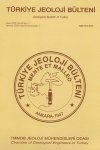
-
2025
-
2024
-
2023
-
2022
-
2021
-
2020
-
2019
-
2018
-
2017
-
2016
-
2015
-
2014
-
2013
-
2012
-
2011
-
2010
-
2009
-
2008
-
2007
-
2006
-
2005
-
2004
-
2003
-
2002
-
2001
-
2000
-
1999
-
1998
-
1997
-
1996
-
1995
-
1994
-
1993
-
1992
-
1991
-
1990
-
1989
-
1988
-
1987
-
1986
-
1985
-
1984
-
1983
-
1982
-
1981
-
1980
-
1979
-
1978
-
1977
-
1976
-
1975
-
1974
- 1973
-
1972
-
1971
-
1970
-
1969
-
1968
-
1966
-
1964
-
1963
-
1961
-
1959
-
1958
-
1955
-
1954
-
1953
-
1952
-
1951
-
1950
-
1949
-
1948
-
1947
Abstract: A Tertiary composite minor intrusion, surrounding the Mourns Mountain granite, is well developed as an inclined cone-sheet The intrusion ofbasic magma has produced thin marginal dolerite, flanking on both sides of arelatively thick, central, granitic granophyre, resulting from subsequent injectionof acid material.
Abstract: La méthode géochronologique Rb-Sr appliquée aux cinq échantillonsde laboratoire tirés de trois échantillons de granodiorites de Gürgenyayfa a permisde calcular des isochrones donnant un âge radiometrique de 45 M.A.- Cet âgeEocène est interprêté comme le dernier rajeunissement d`un massif formé de lapalingenèse d`un matériel d`eugéosynclinal d`âge paléozoique tardif. Le rapportinitial (8 7Sr/8 6Sr)o de cette granodïorite est assez bas (0.707), ce qui permet ded`un géosynclinal d`âge paléozoique tardif; II semble qu`il en est de même poufpenser que la matière originelle du massif de Gürgenyayla provient des sédimentstous les massifs granodioritiques ayant pris place dans le géosynclinal septentrionald`Ânatolie occidentale.
Abstract: Several model types are utilized to observe the kinematics of differentgeological and engineering problems.Kinematic models provide an interpretation of the basic geological data, thatis to establish the allowable failure modes in jointed rock masses. In this study,models were prepared from a special material. The effect of the pattern of jointsystems on the circular tunnels, with varying diameter joint distance ratioswere investigated.
Abstract: Upper Cretaceous-Lower Tertiary sediments (approx. 4O00 m thick)of Yahşihan area, situated between Elmadağ and Kırıkkale, contain various sedimentary structures such as flute, groove, bounce casts... etc as well as.olistostromes and submarine slumps. A basin, oriented NNE-SSW, appears tohave existed at that time. Paleocurrents, olistostromes and submarine slumpsseem to have started from the slopes of the basin; Hhose reaching the bottomturned SSW, parallel to the plunge of the long axis.
Abstract: Post Eocene (probably Oligocène) Alpine paroxysm producedasymmetric folds, generally overturned eastwards. Folding was folloved byupjthrusts, thrusts and right lateral strike-slip faults. A compression couple, initiallyoriented NW-SE, is seen to rotate in time to a N-S position. AH during this timethey appear to be accompanied by a clockwise shear couple.
Abstract: The area is situated around Tufanbeyli (Mağara) 140 km, north öfAdana at the eastern part of Taurus orogenic belt. In this area the rock-stratigraphyunits are named on the formation rank and they are represented from Cambrianto Tertiary. In some localities, apart from the Soğanlı dağı formation, the rock unitsare represented without interruption in their normal stratigraphie position. TheSoğanlı dağı formation is made of Jurassic limestone and other rock types beleivédto have been developed in a different environment, it overlies the Upper CretaceousYaniktepe limestone with a fault contact. In some parts of the field In betweenthe unconformities there are some missing units, this may be explained bypre-unconformity erosion. The unconformities can be classified as disconformityand low angle unconformity. Units in Cambrian-Lutetian period are monotonouslyfolded and faulted suggesting a single orogenic phase. But oscillatory movementswere effective throughout the period. It is thought that the area was subjectedto thrusts and to folding after Lutetian. The fold axes and faults are orientedto NE-SW and thrusts were operating from SE towards NW. As Oligocène andMiocene have not been recorded, the tectonic history of the area can not beestablished after Lutetian. The area is thought to have been developed undershallow» warm, littoral-sublittoral conditions where oscillatory movements wereeffective and show unstable shelf character. No magmatic activity has beenrecorded until the end of Lutetian. With all these characters the area reflects a^miogeosynclinal nature.
Abstract: Les études faites par l`auteur, en 1068 et 1064, dans la régiond*Anamur-Ovacik-SiIifke des Taurus, ont révélé des terrains paléozoïquesinférieurs contenant une riche faune constituée surtout par des Brachiopodes,des Céphalopodes, des Trilobites et des Graptolites. Cette faune a permis àl`auteur pour la première foisP de fixer la présence duTrémadocien, de l`Ordoviciehet du Silurien et, en même temps, d`indiquer quelques-uns de leurs niveauxsfratsgraphîques. L`existence des conglomérats, entre les formations du Trémadocienet du Siluïren, indique une discordance. Les formations paléozoïques inférieuressbnt influencées par l`orogenèse calédonienne. Les terrains fossilifères du Dévonienet du Carbonifère marin et continental sont assez bien développés dans la région.Ces formations sont déformées pendant les mouvements orogéniques hercynienset alpins.
Abstract: Description systematique de quelques espöces dü genre Pecten, Pelecypode.

 TMMOB
TMMOB